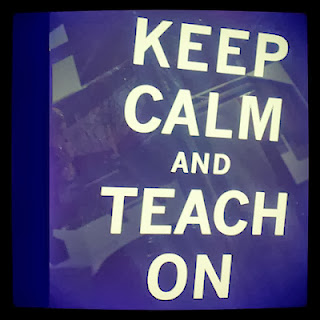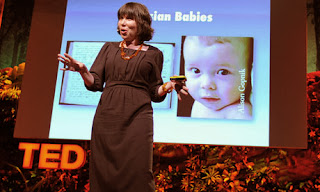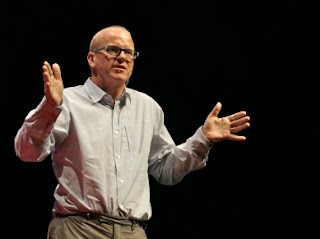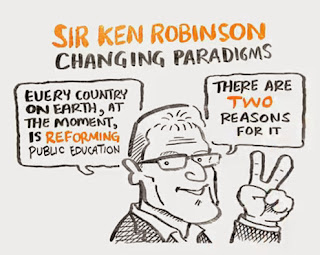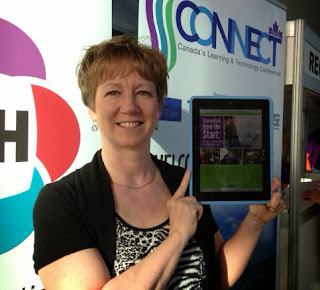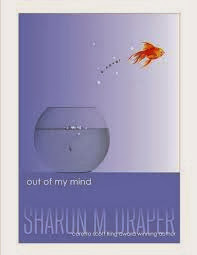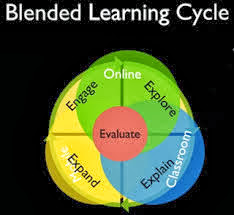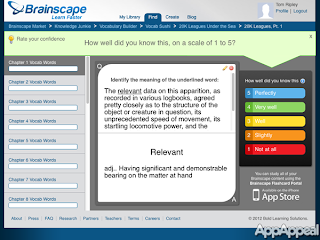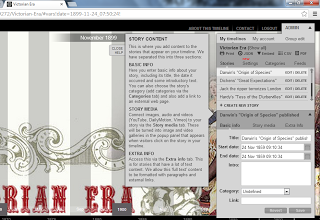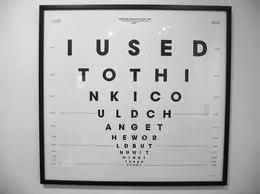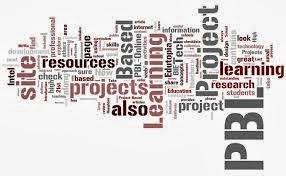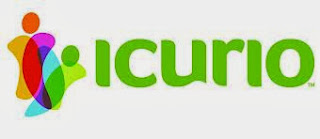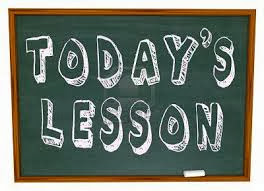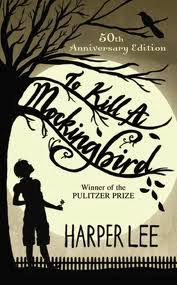Sunday, December 8, 2013
Blog Post #16 Part 1
In preparation for this final blog post I went back and read the first blog post I wrote for this class. Everything I wrote in that post still stands true as to what I want my classroom to look like, what I want my students to learn, what methods I will use in my class, and the technology I will use. However, I now have a better understanding of myself and my ideals for my classroom and students.
My Classroom
I want my classroom to be a place where students find a love for grammar and literature. In today's society most students dread their English class. I do not want my classroom to be that way. I want my class to be a place where my students learn the value of English in their everyday life and take their learning with them into the next phase of their lives.
Activities In My Classroom
I have had the opportunity to learn numerous things through EDM310 about potential activities that could take place in my classroom. I would really love to have a SMARTboard in my classroom so that I could create activities based on grammar. I would have my students complete those activities on the SMARTboard and then get peer feedback. Active participation in a subject will promote understanding of important concepts. Another activity I would like for my students to participate in are having them create small YouTube videos in which they explain concepts of grammar. They could create their activity on the SMARTboard and then have a classmate video it. The reason I would like to do this activity in my classroom is because, if my students can explain the concept enough to create a video on it, then that means that they truly understand the concept.
Methods
One method I know I will use in my classroom is blogging to improve writing skills. I had never blogged until I got into EDM310 and just going back and reading my first blog post I can see a dramatic difference in my writing. Blogging is a wonderful tool to help students with writing and even create a love for writing. My students will blog about concepts we are studying in class and they will also have creative writing assignments. My students will also learn the value of peer editing and commenting through blogging. I will also have my students focus on critical analysis of literary works. I will have my students read certain passages and then as a class we will discuss what could the writer have meant when he/she wrote this portion of the text.
Tools I Will Use In My Classroom
The list of tools to use in the classroom are endless. There are so many wonderful tools and applications available to teachers and students. I know I will use blogging. Blogging has become one of my favorite things to do. I hope to instill that love in my students. I want to use Google Docs and Google Sites to have my students share their works with each other and to create viewable sites for their work or projects. I will have my students use Brainscape as a studying tool. On their iPads, they will use iMovie to create videos on concepts of grammar. In doing research I will have my students log onto iCurio so that they can access Common Core approved sites. These are just a few of the tools I will use in my classroom, but the possibilities are endless.
My Classroom
I want my classroom to be a place where students find a love for grammar and literature. In today's society most students dread their English class. I do not want my classroom to be that way. I want my class to be a place where my students learn the value of English in their everyday life and take their learning with them into the next phase of their lives.
Activities In My Classroom
I have had the opportunity to learn numerous things through EDM310 about potential activities that could take place in my classroom. I would really love to have a SMARTboard in my classroom so that I could create activities based on grammar. I would have my students complete those activities on the SMARTboard and then get peer feedback. Active participation in a subject will promote understanding of important concepts. Another activity I would like for my students to participate in are having them create small YouTube videos in which they explain concepts of grammar. They could create their activity on the SMARTboard and then have a classmate video it. The reason I would like to do this activity in my classroom is because, if my students can explain the concept enough to create a video on it, then that means that they truly understand the concept.
Methods
One method I know I will use in my classroom is blogging to improve writing skills. I had never blogged until I got into EDM310 and just going back and reading my first blog post I can see a dramatic difference in my writing. Blogging is a wonderful tool to help students with writing and even create a love for writing. My students will blog about concepts we are studying in class and they will also have creative writing assignments. My students will also learn the value of peer editing and commenting through blogging. I will also have my students focus on critical analysis of literary works. I will have my students read certain passages and then as a class we will discuss what could the writer have meant when he/she wrote this portion of the text.
Tools I Will Use In My Classroom
The list of tools to use in the classroom are endless. There are so many wonderful tools and applications available to teachers and students. I know I will use blogging. Blogging has become one of my favorite things to do. I hope to instill that love in my students. I want to use Google Docs and Google Sites to have my students share their works with each other and to create viewable sites for their work or projects. I will have my students use Brainscape as a studying tool. On their iPads, they will use iMovie to create videos on concepts of grammar. In doing research I will have my students log onto iCurio so that they can access Common Core approved sites. These are just a few of the tools I will use in my classroom, but the possibilities are endless.
Sunday, December 1, 2013
Blog Post #15
Caitlin Hinton
I have never actually considered the possibility of teaching students with disabilities or special needs. In the school that I attended I honestly cannot remember any students who had disabilities or special needs. There were some students who had trouble understanding, but they just went to what was called resource. I never looked at them as if they had special needs. In saying all of this when I decided I wanted to be an educator, I assumed that I would teach students who had no learning disabilities or special needs. I assumed they would be in their own classroom with teachers who were specialized in that field and could work with them one on one to assist in whatever their individual needs might be. It was not until last year, when I did observations in a high school, that I realized that there were special needs children in regular classes. I almost feel a little bit silly for being so narrow minded. Why shouldn’t those with special needs or learning disabilities have the same experiences and opportunities as someone who does not have disabilities or special needs? Students who have special needs and learning disabilities are given the same opportunity to learn with assistive technologies.
In one of the videos that Dr Strange had us watch for this blog post, Having a great time teaching mom what her deaf/blind child is learning on the iPad, we watch a mom use an iPad and she learns how her child learns on their iPad. It was so neat to see how an iPad can be used and how you do not have to be able to see or hear to use one. On the Microsoft Accessibility website there are numerous tools that could be used depending on what type of disability your student has. There is a product called an alternative input device and this allows students to control their computer through other means instead of a traditional keyboard. One assistive technology that I found that I thought was really neat and it fit my major is a website called Learning Ally. Learning Ally is an assistive technology that is available to educators to help their students who have trouble reading. Learning Ally is a leading provider of audiobooks. Another great reading assistive technology that I discovered is Bookshare. Bookshare is a company whose goal is to make print accessible to people with disabilities. Bookshare makes books available in accessible formats such as digital texts and digital Braille.
I feel that all of the assistive technologies I mentioned above are ones that I could potentially use in my classroom. Literature is a large part of English language arts and with websites like Learning Ally, I could have stories put on audiobook for students who have reading disabilities, and Bookshare, I have stories turned into Braille for a visually impaired students. These are just a few of the assistive technologies that are available to me as an educator. In using these assistive technologies I am giving each of my students the opportunity to succeed in a way that is conducive for their individual needs.
Laura Crawford
Luckily, I decided to take EDU400 this semester. I did not think it would be so immediately rewarding that I decided to do so. The class is entitled “Education for Exceptional Children and Youth” and has well informed me of the challenges I might face even teaching in general education classroom. Since the passing of the “No Child Left Behind” Act, teachers are encouraged to integrate all students into the “Least Restrictive Environment”--especially those with special needs. Considering everything I have learned in that class this semester, these videos were no surprise.
In The Mountbatten, Amy Archer illustrates the wonderful device known as the “Mountbatten” which aids blind students in the process of learning braille. The machine writes Braille for the students using certain buttons or a combination of buttons while a recorded voice on the machine announces the letter the student produced. The Mountbatten can also save files and share them with other computers. As an English teacher, I look forward to working with blind students to enhance their rhetoric and their writing skills using the Mountbatten.
Coincidentally, The Mountbatten is also featured in another one of Amy Archer’s videos entitled ”Assistive Technologies for Vision and Hearing Impaired Children”. This video shows a number of (you guessed it) assistive technologies for vision and hearing impaired children. These devices include Gotalk, a Hearing Information Centre, and as I said The Mountbatten, among many others that remained unnamed in the video. The video is obviously meant to encourage teachers to take the extra step in educating children with special needs. The video also offers information such as, “One in 2500 Australian children have a vision impairment” but its main purpose it obviously to inspire teachers to go beyond the status quo of teaching, which unfortunately rarely considers the needs of special education students.
Ashley Railey
Professor Art Karshmer, of the University of San Francisco School of Management, shows in his video a device he and his team built to teach math to the blind. Professor Karshmer explains that without a knowledge of math blind students cannot from a career in the study of all the core sciences, which rely on math as their root language. Using computers and computer-based devices, Professor Karshmer has devised a system which translates the 2-dimensional realities of mathematical problems into the otherwise single dimensions of braille to allow a blind student to impress those realities into their visual cortex through touch and electronic feedback.
The device is composed of blocks with numbers written in braille and a board to place the block on vertically. The blocks also have a bar code on them that allow the student to scan the bar code and the computer speak the number. The student can align the numbers vertically on the board and solve the problem as a sighted student would.
Wesley Majerus (who is blind) is the Access Specialist for the National Federation for the Blind. In this video, iPad Usage For The Blind, he shows how a blind person uses the iPad. He explains that the iPad is equipped with a voice-over tool. Using this tool he is able to move his figure across the screen and the voice-over tells him the apps he can choose from. Once he finds the app he is searching for, he double taps to open the application. The iPad also has an offers a mainstream e-reader, which reads different books aloud. The e-reader allows him to choose by chapter or page number where to start. Using voice-over he is even able to surf the web.
I thought both of these videos were very intriguing. I didn't attend school with anyone who was blind, therefore I'm not sure of the services that may have been provided. I had never thought about how hard it is for a blind person to learn math. Professor Karshmer's device seems to be a great way to help the visually impaired learn mathematics. I also had no idea the iPad was programmed to service the blind. This is an amazing development in technology!
I have never actually considered the possibility of teaching students with disabilities or special needs. In the school that I attended I honestly cannot remember any students who had disabilities or special needs. There were some students who had trouble understanding, but they just went to what was called resource. I never looked at them as if they had special needs. In saying all of this when I decided I wanted to be an educator, I assumed that I would teach students who had no learning disabilities or special needs. I assumed they would be in their own classroom with teachers who were specialized in that field and could work with them one on one to assist in whatever their individual needs might be. It was not until last year, when I did observations in a high school, that I realized that there were special needs children in regular classes. I almost feel a little bit silly for being so narrow minded. Why shouldn’t those with special needs or learning disabilities have the same experiences and opportunities as someone who does not have disabilities or special needs? Students who have special needs and learning disabilities are given the same opportunity to learn with assistive technologies.
In one of the videos that Dr Strange had us watch for this blog post, Having a great time teaching mom what her deaf/blind child is learning on the iPad, we watch a mom use an iPad and she learns how her child learns on their iPad. It was so neat to see how an iPad can be used and how you do not have to be able to see or hear to use one. On the Microsoft Accessibility website there are numerous tools that could be used depending on what type of disability your student has. There is a product called an alternative input device and this allows students to control their computer through other means instead of a traditional keyboard. One assistive technology that I found that I thought was really neat and it fit my major is a website called Learning Ally. Learning Ally is an assistive technology that is available to educators to help their students who have trouble reading. Learning Ally is a leading provider of audiobooks. Another great reading assistive technology that I discovered is Bookshare. Bookshare is a company whose goal is to make print accessible to people with disabilities. Bookshare makes books available in accessible formats such as digital texts and digital Braille.
I feel that all of the assistive technologies I mentioned above are ones that I could potentially use in my classroom. Literature is a large part of English language arts and with websites like Learning Ally, I could have stories put on audiobook for students who have reading disabilities, and Bookshare, I have stories turned into Braille for a visually impaired students. These are just a few of the assistive technologies that are available to me as an educator. In using these assistive technologies I am giving each of my students the opportunity to succeed in a way that is conducive for their individual needs.
Laura Crawford
Luckily, I decided to take EDU400 this semester. I did not think it would be so immediately rewarding that I decided to do so. The class is entitled “Education for Exceptional Children and Youth” and has well informed me of the challenges I might face even teaching in general education classroom. Since the passing of the “No Child Left Behind” Act, teachers are encouraged to integrate all students into the “Least Restrictive Environment”--especially those with special needs. Considering everything I have learned in that class this semester, these videos were no surprise.
In The Mountbatten, Amy Archer illustrates the wonderful device known as the “Mountbatten” which aids blind students in the process of learning braille. The machine writes Braille for the students using certain buttons or a combination of buttons while a recorded voice on the machine announces the letter the student produced. The Mountbatten can also save files and share them with other computers. As an English teacher, I look forward to working with blind students to enhance their rhetoric and their writing skills using the Mountbatten.
Coincidentally, The Mountbatten is also featured in another one of Amy Archer’s videos entitled ”Assistive Technologies for Vision and Hearing Impaired Children”. This video shows a number of (you guessed it) assistive technologies for vision and hearing impaired children. These devices include Gotalk, a Hearing Information Centre, and as I said The Mountbatten, among many others that remained unnamed in the video. The video is obviously meant to encourage teachers to take the extra step in educating children with special needs. The video also offers information such as, “One in 2500 Australian children have a vision impairment” but its main purpose it obviously to inspire teachers to go beyond the status quo of teaching, which unfortunately rarely considers the needs of special education students.
Ashley Railey
Professor Art Karshmer, of the University of San Francisco School of Management, shows in his video a device he and his team built to teach math to the blind. Professor Karshmer explains that without a knowledge of math blind students cannot from a career in the study of all the core sciences, which rely on math as their root language. Using computers and computer-based devices, Professor Karshmer has devised a system which translates the 2-dimensional realities of mathematical problems into the otherwise single dimensions of braille to allow a blind student to impress those realities into their visual cortex through touch and electronic feedback.
The device is composed of blocks with numbers written in braille and a board to place the block on vertically. The blocks also have a bar code on them that allow the student to scan the bar code and the computer speak the number. The student can align the numbers vertically on the board and solve the problem as a sighted student would.
Wesley Majerus (who is blind) is the Access Specialist for the National Federation for the Blind. In this video, iPad Usage For The Blind, he shows how a blind person uses the iPad. He explains that the iPad is equipped with a voice-over tool. Using this tool he is able to move his figure across the screen and the voice-over tells him the apps he can choose from. Once he finds the app he is searching for, he double taps to open the application. The iPad also has an offers a mainstream e-reader, which reads different books aloud. The e-reader allows him to choose by chapter or page number where to start. Using voice-over he is even able to surf the web.
I thought both of these videos were very intriguing. I didn't attend school with anyone who was blind, therefore I'm not sure of the services that may have been provided. I had never thought about how hard it is for a blind person to learn math. Professor Karshmer's device seems to be a great way to help the visually impaired learn mathematics. I also had no idea the iPad was programmed to service the blind. This is an amazing development in technology!
Sunday, November 24, 2013
C4T #4
In my first C4T I was given Silvia Tolisano. In her most recent blog post she talked about copyright infringement when going through Microsoft Office Clipart Gallery into search engines like Bing. In my comment to her, I told her that I am constantly looking for picture for my blog and that I had never considered what I might be using could be copyrighted. I told her that I enjoyed reading her post and I thanked her for sharing her thoughts on copyright infringement.
In my last C4T for the semester Ms Tolisano wrote about how there is no more middle man in having contact with companies or whomever. She talks about how we have a voice. She recently was working on an infographic in Piktochart and she was looking for a puzzle piece but was having a difficult time finding one. In order to find this puzzle piece she tweeted a message and tagged Piktograph's twitter name in it and less than 3 hours later she had a response and a puzzle piece. In my comment to her, I told her that I loved her blog post. I also said that with the invention of social media sites it is so much easier to communicate directly with companies and other individuals. I thought this was a great blog post.
In my last C4T for the semester Ms Tolisano wrote about how there is no more middle man in having contact with companies or whomever. She talks about how we have a voice. She recently was working on an infographic in Piktochart and she was looking for a puzzle piece but was having a difficult time finding one. In order to find this puzzle piece she tweeted a message and tagged Piktograph's twitter name in it and less than 3 hours later she had a response and a puzzle piece. In my comment to her, I told her that I loved her blog post. I also said that with the invention of social media sites it is so much easier to communicate directly with companies and other individuals. I thought this was a great blog post.
Saturday, November 23, 2013
Final PLN
Throughout the semester I have had to opportunity to expand my personal learning network in various ways. I have used Twitter and blogs to follow certain teachers who I felt were really beneficial to the education system. Some of the teachers I follow are Silvia Tolisano, Kathy Cassidy, Josh Stumpenhorst, Vicki Davis, and Steven Anderson. I really enjoy reading their blog posts and their Twitter feeds. I feel that they all put our quality work that will help me in my endeavors to become an educator.
Blog Post #14
For this blog post, our assignment is to create a blog post that Dr. Strange did not assign us but should have assigned us in our area of specialty. As I somewhat wracked my brain to figure out what I should write about, it became clear to me that I should blog about what we have done the entire semester which of course is blogging! I have grown to love blogging and that is something that I would like to instill in my future students. So, for my blog post I will blog about “How will I use blogging in my future English language arts classes?”
Blog Post #14-How will I use blogging in my future English language arts classes?
Blogging is something I have become very passionate about over the last couple of months. I have grown to love it so much that I created a blog just to express my thoughts on. In my future classroom I will use blogging with my students. I feel that there are numerous advantages to blogging.
One way I will incorporate blogging into my classroom is by having a class blog for each of my classes that my students will actively participate in. Each week my students will have to complete one blog post and submit it by a certain day. They will write about topics such as why is grammar and usage important, what was your favorite work by Edgar Allan Poe and why? I would also like them to have a blog post once every other week that is a creative writing blog post.
I feel that one of the greatest advantages of blogging is its enhancing effect on writing skills. I felt like I was a pretty good writer before entering this course and after blogging for almost the entire semester, I feel that I have become and even better writer. I hope that blogging will be the same for my students. They will have a blog that they will be responsible for. They must submit their assignments on time and they should be proofread and edited by their peers. This can be done through google docs. They will have assignments that will deal with what we are discussing in class as well as assignments that will be creative writing assignments. At the end of the semester I would like them to write a final blog post that gives a detailed trip of their journey through blogging and what they feel they have learned and what they will take away from blogging.
These are just some of the ideas I have for using blogging in my future class. I love blogging and I hope my students will too. Blogging has helped me become a better writer and it has also helped me with being responsible for my work and deadlines. These are just some of the important aspects of blogging that I hope to share with my future English classes.
Blog Post #14-How will I use blogging in my future English language arts classes?
Blogging is something I have become very passionate about over the last couple of months. I have grown to love it so much that I created a blog just to express my thoughts on. In my future classroom I will use blogging with my students. I feel that there are numerous advantages to blogging.
One way I will incorporate blogging into my classroom is by having a class blog for each of my classes that my students will actively participate in. Each week my students will have to complete one blog post and submit it by a certain day. They will write about topics such as why is grammar and usage important, what was your favorite work by Edgar Allan Poe and why? I would also like them to have a blog post once every other week that is a creative writing blog post.
I feel that one of the greatest advantages of blogging is its enhancing effect on writing skills. I felt like I was a pretty good writer before entering this course and after blogging for almost the entire semester, I feel that I have become and even better writer. I hope that blogging will be the same for my students. They will have a blog that they will be responsible for. They must submit their assignments on time and they should be proofread and edited by their peers. This can be done through google docs. They will have assignments that will deal with what we are discussing in class as well as assignments that will be creative writing assignments. At the end of the semester I would like them to write a final blog post that gives a detailed trip of their journey through blogging and what they feel they have learned and what they will take away from blogging.
These are just some of the ideas I have for using blogging in my future class. I love blogging and I hope my students will too. Blogging has helped me become a better writer and it has also helped me with being responsible for my work and deadlines. These are just some of the important aspects of blogging that I hope to share with my future English classes.
Tuesday, November 19, 2013
C4K Summary For November
For my first C4K for November, I was assigned a student named Mikaiah from New Zealand. In Mikaiah's blog post she wrote about her first day of school. She talked about being nervous because this was a totally new experience for her. She said she asked a boy named James if she could play handball with him and he said yes. In my comment to Mikaiah I told her that I knew how she felt and I told her that I was ver nervous my first day of school as well. I told her it can be scary when we experience things that we are not used to. I told her that she did a good job on her blog post and to keep up the good work.
For my last C4K for November I read the blog of a student named Kaya. In her blog post she talks about using the cross walk when crossing the street. She has a video on her blog in which she talks about this. In my comment to her, I told her who I was and that I enjoyed her post. I told her it is very important to be safe when crossing the street and the way to do that is by using a crosswalk.
For my last C4K for November I read the blog of a student named Kaya. In her blog post she talks about using the cross walk when crossing the street. She has a video on her blog in which she talks about this. In my comment to her, I told her who I was and that I enjoyed her post. I told her it is very important to be safe when crossing the street and the way to do that is by using a crosswalk.
Sunday, November 17, 2013
Blog Post #13
Kakenya Ntaiya: A Girl Who Demanded School
Caitlin Hinton
In this TED talk given by Kakenya Ntaiya we learn of a girl who demanded school. Kakenya is a woman who grew up in Kenya and she belongs to the Maasai’s. When Kakenya was a young girl was told that she had a man who was waiting to marry her, but she would have to be older. Kakenya went to school as a young girl and she dreamt of being a teacher. When she was 12 she went through a female right of passage within her community. In the Maasai tradition young girls who have reached puberty are subjected to female genital mutilation. Most of the girls who go through this die from loss of blood. Kakenya, who did not want to quit going to school, made a deal with her father. Kakenya asked her father if she went through with the Maasai ritual if he would allow her to go to high school and he agreed. At the age of 12 Kakenya and other girls went through what was probably one of the most painful experiences of their lives. Thankfully Kakenya survived and continued on to high school. In the mind of the Maasai what they subject these young girls to is just a part of their culture and in order for a girl to become a wife she must go through this or it will bring tremendous shame on her family. When Kakenya applied to college in America and started school, it was then that she learned that female genital mutilation was against the law in Kenya. It was from that point on that Kakenya decided she had to do something about this. She decided that she would start a school for girls in her community. The girls who attend this school are not subjected to the horrific act of female genital mutilation and they have a future that is attainable and bright. When I watched this video I honestly felt guilty. How many times do I take my education for granted? In America we are truly blessed not only with education but with education that is full of technological advantages. We are given the opportunity to be whatever we dream of being. In other parts of the world, such as Kenya, children are not encouraged to dream and become the person they want to be, but instead are told what their roles are within their communities and they must follow them. Our children are given stable environments to learn and flourish in. An education is something that should never be taken away from a child or anyone for that matter. I feel as educators we should always encourage our students to dream and challenge them to become whatever it is that they want to be. It is important to remember that our education is important because there are people all around the world who would love to sit in a classroom and be given the opportunity to learn. We must never take our education for granted. Kakenya Ntaiya’s story is a story of hope and inspiration and I think that we could all take something away from the story of the girl who demanded school.
Alison Gopnik: What Do Babies Think
Ashley Railey
As I looked through the list of TED talks, my mind was fixed on the first listed. What do babies think? Since I have three kids, I’ve often asked myself the same thing. Alison Gopnik explains in her lecture that a baby or young child’s mind is a lot more complex than we have thought in the past. Children are constantly observing and learning behavior from adults. She explains that because they are taken care of for so long, their brains can focus on learning rather than surviving. Gopnik compares human babies to those of other animals. She says that the longer a baby is nurtured by it’s mother, the smarter the species is. For example, some crows and ravens feed their young for up to two years. This is a very long time in the life span of a bird. On the other hand, the domestic chicken matures in a couple of months. Gopnik explains that childhood is the reason why crows end up on the cover of science magazines while the chicken ends up as lunch. Gopnik states,”Another way of thinking about it is instead of thinking of babies and children as being like defective grownups, we should think about them as being a different developmental stage of the same species, kind of like caterpillars and butterflies. Except that they're actually the brilliant butterflies who are flitting around the garden and exploring, and we're the caterpillars who are inching along our narrow, grownup, adult path.” Division of labor between the adults and children are what helps us survive as humans. Babies and young children are completely helpless and rely on their mother’s care for the first decade of their lives. This way the children can spend all of their time learning and not on sheer survival. Once we reach adulthood, we can take all the things we learned as children and apply them to our daily lives. Gopnik suggests that babies are like scientist. They develop a hypothesis and go out and test it. Depending on the outcome they may change that hypothesis. To test her theory, she used a machine called the Blicket Detector. The Blicket Detector is a machine that lights up when you put some things on it and not others. Gopnik explains:
Charles Leadbeater: Education Innovation In The Slums
Laura Crawford
In this presentation, Mr. Leadbeater summarizes the effects of varying programs worldwide that have successfully integrated technology into “slums” for education’s sake. Leadbeater begins his presentation with this intriguing thought: “Your vantage point determines what you can see…The question that you ask will determine much of the answer that you get”. The question that follows is: “Where do we look to see what education will become?” Leadbeater seems to regret that most educators answer with “go to Finland.” However, he spent time studying over a hundred case studies of how education has improved in the most impoverished regions of the world.
Caitlin Hinton
In this TED talk given by Kakenya Ntaiya we learn of a girl who demanded school. Kakenya is a woman who grew up in Kenya and she belongs to the Maasai’s. When Kakenya was a young girl was told that she had a man who was waiting to marry her, but she would have to be older. Kakenya went to school as a young girl and she dreamt of being a teacher. When she was 12 she went through a female right of passage within her community. In the Maasai tradition young girls who have reached puberty are subjected to female genital mutilation. Most of the girls who go through this die from loss of blood. Kakenya, who did not want to quit going to school, made a deal with her father. Kakenya asked her father if she went through with the Maasai ritual if he would allow her to go to high school and he agreed. At the age of 12 Kakenya and other girls went through what was probably one of the most painful experiences of their lives. Thankfully Kakenya survived and continued on to high school. In the mind of the Maasai what they subject these young girls to is just a part of their culture and in order for a girl to become a wife she must go through this or it will bring tremendous shame on her family. When Kakenya applied to college in America and started school, it was then that she learned that female genital mutilation was against the law in Kenya. It was from that point on that Kakenya decided she had to do something about this. She decided that she would start a school for girls in her community. The girls who attend this school are not subjected to the horrific act of female genital mutilation and they have a future that is attainable and bright. When I watched this video I honestly felt guilty. How many times do I take my education for granted? In America we are truly blessed not only with education but with education that is full of technological advantages. We are given the opportunity to be whatever we dream of being. In other parts of the world, such as Kenya, children are not encouraged to dream and become the person they want to be, but instead are told what their roles are within their communities and they must follow them. Our children are given stable environments to learn and flourish in. An education is something that should never be taken away from a child or anyone for that matter. I feel as educators we should always encourage our students to dream and challenge them to become whatever it is that they want to be. It is important to remember that our education is important because there are people all around the world who would love to sit in a classroom and be given the opportunity to learn. We must never take our education for granted. Kakenya Ntaiya’s story is a story of hope and inspiration and I think that we could all take something away from the story of the girl who demanded school.
Alison Gopnik: What Do Babies Think
Ashley Railey
As I looked through the list of TED talks, my mind was fixed on the first listed. What do babies think? Since I have three kids, I’ve often asked myself the same thing. Alison Gopnik explains in her lecture that a baby or young child’s mind is a lot more complex than we have thought in the past. Children are constantly observing and learning behavior from adults. She explains that because they are taken care of for so long, their brains can focus on learning rather than surviving. Gopnik compares human babies to those of other animals. She says that the longer a baby is nurtured by it’s mother, the smarter the species is. For example, some crows and ravens feed their young for up to two years. This is a very long time in the life span of a bird. On the other hand, the domestic chicken matures in a couple of months. Gopnik explains that childhood is the reason why crows end up on the cover of science magazines while the chicken ends up as lunch. Gopnik states,”Another way of thinking about it is instead of thinking of babies and children as being like defective grownups, we should think about them as being a different developmental stage of the same species, kind of like caterpillars and butterflies. Except that they're actually the brilliant butterflies who are flitting around the garden and exploring, and we're the caterpillars who are inching along our narrow, grownup, adult path.” Division of labor between the adults and children are what helps us survive as humans. Babies and young children are completely helpless and rely on their mother’s care for the first decade of their lives. This way the children can spend all of their time learning and not on sheer survival. Once we reach adulthood, we can take all the things we learned as children and apply them to our daily lives. Gopnik suggests that babies are like scientist. They develop a hypothesis and go out and test it. Depending on the outcome they may change that hypothesis. To test her theory, she used a machine called the Blicket Detector. The Blicket Detector is a machine that lights up when you put some things on it and not others. Gopnik explains:
“If I showed you this detector, you would be likely to think, to begin with, that the way to make the detector go would be to put a block on top of the detector. But actually, this detector works in a bit of a strange way. Because if you wave a block over the top of the detector, something you wouldn't ever think of to begin with, the detector will actually activate two out of three times. Whereas, if you do the likely thing, put the block on the detector, it will only activate two out of six times. So the unlikely hypothesis actually has stronger evidence. It looks as if the waving is a more effective strategy than the other strategy. So we did just this; we gave four year-olds this pattern of evidence, and we just asked them to make it go . And sure enough, the four year-olds used the evidence to wave the object on the top of the detector.”At four years old children are just learning to count, but these kids were doing complicated calculations to discover the probability. The kids were forming ideas from the Blicket Detector and coming up with a hypothesis. I thought Alison Gopnik’s lecture was remarkable. I had never realized how complex a young child’s mind really is. My youngest daughter is 14 months old. When she is mumbling and rattling to me, as if she is having a full conversation in baby talk, I wonder what is going through her mind. I think now, that maybe she is trying to convey to me everything she already knows but cannot voice. Gopnik ends her lecture by saying, “ If what we want is to be like those butterflies, to have open-mindedness, open learning, imagination, creativity, innovation, maybe at least some of the time we should be getting the adults to start thinking more like children.”
Charles Leadbeater: Education Innovation In The Slums
Laura Crawford
In this presentation, Mr. Leadbeater summarizes the effects of varying programs worldwide that have successfully integrated technology into “slums” for education’s sake. Leadbeater begins his presentation with this intriguing thought: “Your vantage point determines what you can see…The question that you ask will determine much of the answer that you get”. The question that follows is: “Where do we look to see what education will become?” Leadbeater seems to regret that most educators answer with “go to Finland.” However, he spent time studying over a hundred case studies of how education has improved in the most impoverished regions of the world.
“Radical innovation does sometimes come from the very best [i.e. Finland]. But it often comes from places where you have huge need, unmet latent demands and not enough resources for traditional [high-cost] solutions to work which depend on professionals.”The aforementioned quotation best summarizes Mr. Leadbeater’s endeavor. The prevalent theme in all the programs he studied seemed to be the integration of technology. As he stated, the most successful programs used “technology for learning that made learning fun and accessible”. This is because “education in these settings works by pull, not push.” Leadbeater laments that “most of our education works by push” and has since the early 19th century when the Bismarckian structure of the educational system was created. However, in today’s times, it becomes clearer every day that this system is entirely obsolete. In the words of Mr. Leadbeater, “education needs to work by pull, not push.” Leadbeater suggests that the key to educating students successfully is by motivating them to pursue knowledge on their own. This motivation may be either extrinsic or intrinsic. Leadbeater defines extrinsic motivation as the “pay off” (in our culture, it would be a potential job). However, Mr. Leadbeater also notes that the extrinsic motivators prevalent in our culture are often too far away (i.e. ten years) which does not coincide with the immediate gratification mindset of kids today. Leadbeater then invites his audience to “imagine an educational system that started from a question, not imposed knowledge” and the consequences of a system set around this type of learning. Leadbeater emphasizes that “you have to engage people first in order to teach them”. An interesting comparison that Leadbeater makes is between Chinese restaurants and the McDonald’s chain. He encourages that schools be like Chinese restaurants, in that—there is no chain (standardization) but you can still easily identify a Chinese restaurant when you see one. McDonald’s, however, is held to a standard. Every McDonald’s in every city in every country in the world has the exact same standard and menu. Leadbeater enunciates that this absolutely should not be the case in schools. Schools need to meet the curriculum of the community attending them. Leadbeater then invites his audience to consider the alternative to the way schools are enforced today (by sustaining innovation in a formal setting) to disruptive innovation in an informal setting. Leadbeater encourages the latter which advocates “high collaboration, personalized [attention to students], high [standard of] technology[…]where learning starts from questions not from curriculum” Mr. Leadbeater concludes by reiterating that “the 19th century Bismarckian [model]schools lay waste to imagination, to appetite” and “stratify society as much as it benefits it”. His closing line is a powerful one as he concludes: “We are bequeathing to the developing world school systems that they will now spend a century trying to reform.”
Sunday, November 10, 2013
Blog Post #12
How To Escape Educations Death Valley
Caitlin Hinton
In this TED talk about education, Ken Robinson talks about how to escape educations death valley. Ken Robinson, who is a native of England, opens with the a joke about Americans not understanding irony. He then goes onto say that whoever came up with the title “No Child Left Behind,” clearly understands irony. He says that the legislation of “No Child Left Behind,” is actually leaving millions of children behind. In some parts of the country 60% of students drop out of school, but this is just the tip of the iceberg. The dropout crisis does not include the students who are actively in school but are completely disengaged from school. Robinson delivers three ways in which the human life flourishes and they are contradicted by the culture of education. The first being, human beings are naturally different and diverse. Robinson gives the illustration that if you have two children, more than likely they are completely different from one another. He states that education under “No Child Left Behind,” is not based on diversity, but conformity. Schools are encouraged to find out what students can do across a very narrow spectrum of achievement. Education should be well dispersed and equal throughout all subjects. Children prosper best with a broad curriculum that celebrates their various talents. The second principle by which human life flourishes is curiosity. Robinson says that if you can light the spark of curiosity in a child they will learn without any further assistance in most cases. Curiosity is the engine of achievement. Education is about learning and if there is no learning going on then there is no education. The role of a teacher is to facilitate learning. Robinson proposes that one of the problems is that the culture of education focuses not on teaching and learning but on testing. Testing should support learning not obstruct it. In place of curiosity is a culture of compliance. The third principle is that human life is inherently creative. Humans can create and recreate their lives. Education is supposed to awaken the powers of creativity but instead we have a culture of standardization. So with these three principles in mind, how do we escape educations death valley? Simply put, we bring to life what lies dormant in our students. We foster our students diversity, curiosity, and creativity. The education system is not a mechanical system, it is a human system. We must create a climate of possibility and by doing that our students will rise and flourish.
Changing Education Paradigms
Laura Crawford
Ken Robinson begins his talk “Changing Education Paradigms” by suggesting two reasons every country on the planet is changing their education system. The first is economic; the question being “how do we educate our children to take their place in the economies of the 21st century?” The second reason is cultural. Ken Robinson states that every country on earth is trying to figure out how to educate children so they have a sense of cultural identity while being a part of the process of globalization. The problem seems to begin with the roots of the current education system. Ken Robinson says that the current system of education was designed and conceived and structured for a different age—the enlightenment and the industrial revolution. The Enlightenment view of intelligence was really an equation in and of itself: capability of deductive reasoning is completely equivalent to academic ability. This system leaves otherwise brilliant people under the impression that they are dumb and stuck in their lower-paying jobs. Ken Robinson then suggests that these twin pillars (economic and intellectual) create chaos for most people. Furthermore, Sir Robinson addresses the issue of ADHD—an epidemic that he claims isn’t really an epidemic. Ken Robinson claims our children are living in the most intensely stimulating period in the history of the earth. What’s interesting is that the instances of ADHD have positively correlated with the increase of standardized testing. Sir Robinson points out that in America, ADHD increases as you go east. What decreases as you go east is the funding for the arts. Robinson states: “the arts are the victims of this mentality”. Arts emphasize the aesthetic appeal—the parts of the brain that are equally stimulated by the media, video games, and advertising surrounding students today. The arts are battled, however, mostly by anesthetics (the medication prescribed for ADHD) that deafen the brain to these stimulating experiences. Ken Robinson states that children are readily “medicated as routinely as we had our tonsils taken out”. His next point of emphasis was the assembly-line mentality taken in schools toward education. He asks “why is their age the most important thing?” and really hits the idea with his comedic comment: “it’s like their date of manufacture”. This production line mentality is conforming students through standardization (of tests, scores, grades, etc.). Ken Robinson seems to be a proponent of divergent thinking, which is frequently confused with creativity but isn’t. Sir Robinson suggests that divergent thinking is actually an essential capacity of creativity. He defines it as “the ability to see many possible answers to a question, of interpreting a question” Basically, thinking more relationally than linearly. Sir Robinson supports this idea of education with empirical evidence from a longitudinal study. The study encouraged kindergarten children to answer questions with as many possibilities as they could conceive, instead of enforcing this idea that there is only one answer in the back of the book. The study basically concluded that as we age, we lose the capacity to see multiple possible solutions to a problem. We are taught that there is only one answer and that is what we assume to believe. Ken Robinson closes his talk with the four things we need to solve before education systems will improve. First, we have to think differently about human capacity for knowledge. Second, we have to recognize the academia myth. Third, we have to recognize that kids learn best collaboratively and we should not isolate them and judge them separately. The final is the recognition of the habits of institutions and the habitats that they occupy.
The Importance of Creativity
Ashley Railey
Ken Robinson begins his lecture by explaining how children have extraordinary capacities for innovation. He believes that each child has an individual creative talent that teachers (or adults in general) ignore. Robinson says, “My contention is that creativity now is as important in education as literacy, and we should treat it with the same status.”
Robinson continues his lecture with a few humorous jokes that keep the audience, and myself, laughing. He tells the story of his four year old son being in The Nativity Play when he was four. When the play begins, three four year boys come out as the kings who offer Jesus gold, myrrh, and frankincense. The first boy says, “I bring you gold”; the second boy says, “I bring you myrrh”; and the third boy says, “Frank sent this.” The point of his story is that children aren’t afraid of being wrong. This isn’t to say that being wrong is the same as being creative. Robinson states, “If you aren’t prepared to be wrong you will never come up with anything original.” By the time most children are adults they have developed a fear of being wrong. When education sells that mistakes are the worst thing a child can do, the result is that we are educating people out of their creativity.
Robinson explains how the current state of education models students to become college professors. Our society only focuses on math, science, and literacy. This only allows for the few students who are gifted in these areas to succeed.
I thought Robinson’s lecture was very entertaining and insightful. Personally, I don’t have a creative bone in my body, but I do appreciate art and literature. Our education system should embrace each child’s creativity. When students are learning about what they love, it provides them with more resources for a successful future.
Robinson ends his lecture with this powerful statement, “I believe our only hope for the future is to adopt a new conception of human ecology. One in which we start to reconstitute our conception of the richness of human capacity. Our education system has mined our minds in the way that we’ve stripped mined the Earth looking for a particular commodity, and for the future it won’t service.”
Caitlin Hinton
In this TED talk about education, Ken Robinson talks about how to escape educations death valley. Ken Robinson, who is a native of England, opens with the a joke about Americans not understanding irony. He then goes onto say that whoever came up with the title “No Child Left Behind,” clearly understands irony. He says that the legislation of “No Child Left Behind,” is actually leaving millions of children behind. In some parts of the country 60% of students drop out of school, but this is just the tip of the iceberg. The dropout crisis does not include the students who are actively in school but are completely disengaged from school. Robinson delivers three ways in which the human life flourishes and they are contradicted by the culture of education. The first being, human beings are naturally different and diverse. Robinson gives the illustration that if you have two children, more than likely they are completely different from one another. He states that education under “No Child Left Behind,” is not based on diversity, but conformity. Schools are encouraged to find out what students can do across a very narrow spectrum of achievement. Education should be well dispersed and equal throughout all subjects. Children prosper best with a broad curriculum that celebrates their various talents. The second principle by which human life flourishes is curiosity. Robinson says that if you can light the spark of curiosity in a child they will learn without any further assistance in most cases. Curiosity is the engine of achievement. Education is about learning and if there is no learning going on then there is no education. The role of a teacher is to facilitate learning. Robinson proposes that one of the problems is that the culture of education focuses not on teaching and learning but on testing. Testing should support learning not obstruct it. In place of curiosity is a culture of compliance. The third principle is that human life is inherently creative. Humans can create and recreate their lives. Education is supposed to awaken the powers of creativity but instead we have a culture of standardization. So with these three principles in mind, how do we escape educations death valley? Simply put, we bring to life what lies dormant in our students. We foster our students diversity, curiosity, and creativity. The education system is not a mechanical system, it is a human system. We must create a climate of possibility and by doing that our students will rise and flourish.
Changing Education Paradigms
Laura Crawford
Ken Robinson begins his talk “Changing Education Paradigms” by suggesting two reasons every country on the planet is changing their education system. The first is economic; the question being “how do we educate our children to take their place in the economies of the 21st century?” The second reason is cultural. Ken Robinson states that every country on earth is trying to figure out how to educate children so they have a sense of cultural identity while being a part of the process of globalization. The problem seems to begin with the roots of the current education system. Ken Robinson says that the current system of education was designed and conceived and structured for a different age—the enlightenment and the industrial revolution. The Enlightenment view of intelligence was really an equation in and of itself: capability of deductive reasoning is completely equivalent to academic ability. This system leaves otherwise brilliant people under the impression that they are dumb and stuck in their lower-paying jobs. Ken Robinson then suggests that these twin pillars (economic and intellectual) create chaos for most people. Furthermore, Sir Robinson addresses the issue of ADHD—an epidemic that he claims isn’t really an epidemic. Ken Robinson claims our children are living in the most intensely stimulating period in the history of the earth. What’s interesting is that the instances of ADHD have positively correlated with the increase of standardized testing. Sir Robinson points out that in America, ADHD increases as you go east. What decreases as you go east is the funding for the arts. Robinson states: “the arts are the victims of this mentality”. Arts emphasize the aesthetic appeal—the parts of the brain that are equally stimulated by the media, video games, and advertising surrounding students today. The arts are battled, however, mostly by anesthetics (the medication prescribed for ADHD) that deafen the brain to these stimulating experiences. Ken Robinson states that children are readily “medicated as routinely as we had our tonsils taken out”. His next point of emphasis was the assembly-line mentality taken in schools toward education. He asks “why is their age the most important thing?” and really hits the idea with his comedic comment: “it’s like their date of manufacture”. This production line mentality is conforming students through standardization (of tests, scores, grades, etc.). Ken Robinson seems to be a proponent of divergent thinking, which is frequently confused with creativity but isn’t. Sir Robinson suggests that divergent thinking is actually an essential capacity of creativity. He defines it as “the ability to see many possible answers to a question, of interpreting a question” Basically, thinking more relationally than linearly. Sir Robinson supports this idea of education with empirical evidence from a longitudinal study. The study encouraged kindergarten children to answer questions with as many possibilities as they could conceive, instead of enforcing this idea that there is only one answer in the back of the book. The study basically concluded that as we age, we lose the capacity to see multiple possible solutions to a problem. We are taught that there is only one answer and that is what we assume to believe. Ken Robinson closes his talk with the four things we need to solve before education systems will improve. First, we have to think differently about human capacity for knowledge. Second, we have to recognize the academia myth. Third, we have to recognize that kids learn best collaboratively and we should not isolate them and judge them separately. The final is the recognition of the habits of institutions and the habitats that they occupy.
The Importance of Creativity
Ashley Railey
Ken Robinson begins his lecture by explaining how children have extraordinary capacities for innovation. He believes that each child has an individual creative talent that teachers (or adults in general) ignore. Robinson says, “My contention is that creativity now is as important in education as literacy, and we should treat it with the same status.”
Robinson continues his lecture with a few humorous jokes that keep the audience, and myself, laughing. He tells the story of his four year old son being in The Nativity Play when he was four. When the play begins, three four year boys come out as the kings who offer Jesus gold, myrrh, and frankincense. The first boy says, “I bring you gold”; the second boy says, “I bring you myrrh”; and the third boy says, “Frank sent this.” The point of his story is that children aren’t afraid of being wrong. This isn’t to say that being wrong is the same as being creative. Robinson states, “If you aren’t prepared to be wrong you will never come up with anything original.” By the time most children are adults they have developed a fear of being wrong. When education sells that mistakes are the worst thing a child can do, the result is that we are educating people out of their creativity.
Robinson explains how the current state of education models students to become college professors. Our society only focuses on math, science, and literacy. This only allows for the few students who are gifted in these areas to succeed.
I thought Robinson’s lecture was very entertaining and insightful. Personally, I don’t have a creative bone in my body, but I do appreciate art and literature. Our education system should embrace each child’s creativity. When students are learning about what they love, it provides them with more resources for a successful future.
Robinson ends his lecture with this powerful statement, “I believe our only hope for the future is to adopt a new conception of human ecology. One in which we start to reconstitute our conception of the richness of human capacity. Our education system has mined our minds in the way that we’ve stripped mined the Earth looking for a particular commodity, and for the future it won’t service.”
Project Based Learning Plan #3
In this lesson plan, I will have my students create a presentation based on one of Edgar Allan Poe's stories. I have created a site for my students to access. They can view the overview, calendar, and rubrics for the project within the site. To view the entire lesson plan click here.
Sunday, November 3, 2013
Blog Post #11
For this assignment we watched a 3 part interview with Kathy Cassidy, a first grade teacher in Moose Jaw, SK, Canada. Mrs. Cassidy uses technology in her classroom on a daily basis. She has a classroom blog that allows all of her students to make blog posts and leave comments on classmates blogs. In this interview she talks about the ways she uses technology in her classroom and the importance of it.
There are a number of ways to approach using technology in the classroom. One way is to simply start somewhere. Mrs. Cassidy suggests starting with something that you like. If you like to take photos, then create a Flikr account. If you like to write, then create a blog on Blogspot or Wordpress. Once you get started, you can implement that into your classroom and get your students on a path to being technologically savvy.
One of the techniques I would like to use in my classroom is having a class blog. I feel that blogging is a great tool to use in your classroom for the benefit of your students. I would like to have my students blog on a weekly basis and leave comments for their peers. Another technique I will also use is teaching them the importance of proper peer editing and commenting. It is important to have respect for your peers and that importance is carried over into the comments my students will leave on their peers blog pages.
One impediment that I could encounter is my students running into sites that are not appropriate. You can find anything on the internet and with those kind of limitless possibilities, it is possible to run across sites or images that could be inappropriate for my students. I intend to educate my students on the importance of internet safety, such as not posting their last name or posting pictures of themselves. I will also teach them what to do if they are to end up on a site that they should not be on. I feel that it will be important to emphasize as well that they should not be on a site that is not an aid in learning. If the site has nothing to do with what we are currently working on, then they should not be on the site.
There are incredible benefits to using some of the approaches that Mrs. Cassidy uses. I think that one of the greatest benefits the students receive from creating a blog is they can see the progress they are making. The blog acts as a type of portfolio. It displays their work and it gives a great timeline of how far they have come each week. It is also beneficial for the parents. It allows them to see what their children are doing and it lets them know what is going on in the classroom.
There are a number of ways to approach using technology in the classroom. One way is to simply start somewhere. Mrs. Cassidy suggests starting with something that you like. If you like to take photos, then create a Flikr account. If you like to write, then create a blog on Blogspot or Wordpress. Once you get started, you can implement that into your classroom and get your students on a path to being technologically savvy.
One of the techniques I would like to use in my classroom is having a class blog. I feel that blogging is a great tool to use in your classroom for the benefit of your students. I would like to have my students blog on a weekly basis and leave comments for their peers. Another technique I will also use is teaching them the importance of proper peer editing and commenting. It is important to have respect for your peers and that importance is carried over into the comments my students will leave on their peers blog pages.
One impediment that I could encounter is my students running into sites that are not appropriate. You can find anything on the internet and with those kind of limitless possibilities, it is possible to run across sites or images that could be inappropriate for my students. I intend to educate my students on the importance of internet safety, such as not posting their last name or posting pictures of themselves. I will also teach them what to do if they are to end up on a site that they should not be on. I feel that it will be important to emphasize as well that they should not be on a site that is not an aid in learning. If the site has nothing to do with what we are currently working on, then they should not be on the site.
There are incredible benefits to using some of the approaches that Mrs. Cassidy uses. I think that one of the greatest benefits the students receive from creating a blog is they can see the progress they are making. The blog acts as a type of portfolio. It displays their work and it gives a great timeline of how far they have come each week. It is also beneficial for the parents. It allows them to see what their children are doing and it lets them know what is going on in the classroom.
C4T #3
For my first entry in C4T #3 I was assigned Vicki Davis. Vicki Davis is a full time teacher in Camilla, Georgia. In her most recent blog post she talks about the new update to Windows 8. She states that the update adds a lot of features and improvements across the OS. She also mentions there is a great deal of new things to do with photo editing. In my comment to her I stated my name and where I attended school. I told her that her blog post was very useful and good information to know.
For my second C4T, Ms. Davis blogged about why she is moving from blogger to wordpress. In her post she gives five reasons as to why she is moving her blog. Her first reason was she likes that wordpress has more add ins and flexibility. Secondly, she said that she was concerned about googles new terms of service. Thirdly, she states that free can cost you everything, so pay for valuable services. Fourthly, she said simply that it is time to move on. Finally, she says that her blog on wordpress will not be blocked in schools like it is on blogspot. In my comment to her I told her I enjoyed reading her post and that I had never considered wordpress even though I knew several people who had a blog on wordpress. I told her she made a lot of excellent points.
For my second C4T, Ms. Davis blogged about why she is moving from blogger to wordpress. In her post she gives five reasons as to why she is moving her blog. Her first reason was she likes that wordpress has more add ins and flexibility. Secondly, she said that she was concerned about googles new terms of service. Thirdly, she states that free can cost you everything, so pay for valuable services. Fourthly, she said simply that it is time to move on. Finally, she says that her blog on wordpress will not be blocked in schools like it is on blogspot. In my comment to her I told her I enjoyed reading her post and that I had never considered wordpress even though I knew several people who had a blog on wordpress. I told her she made a lot of excellent points.
C4K Summary For October
In my first C4K for October I had the opportunity to read a blog that belonged to a girl named Aisha. In Aisha's blog post, she blogged about service dogs. She told a story about a girl named Melody who had fallen out of her wheelchair and her service dog Butterscotch helped her up. She offered a website to learn more about service dogs. In my comment to Aisha, I told her that I really enjoyed her blog post about service dogs. I told her that service dogs were intelligent and loyal animals.
In my second C4K I was assigned a student by the name of Lizzie. In Lizzie's blog post she talked about moss, lichen, and fungus. She gave adequate descriptions of each. In my comment to her I told her that I really enjoyed her blog post and that I thought she gave good descriptions of moss, lichen, and fungus and that she had really good pictures.
In my third C4K I was given a student from New Zealand named Ben. In Ben's most recent blog post he wrote about komodo dragons. Ben went into great detail about the komodo dragons habitat, what they eat and how they catch their prey. Ben talked about what komodo dragons look like and how big they can become. Ben also talked about what it is like for baby komodo dragons during the first six to eight months of their lives. In my comment to Ben, I shared with him who I was and that he had done a good job on his blog post. I also shared with him that before reading his blog post I did not know much about komodo dragons and after reading his post I felt that I knew a great deal. Ben did a really great job on his blog post.
In my fourth C4K I was given a student named Danielle. In her most recent blog post she wrote an entry about the book Out Of My Mind by Sharon M. Draper. I told Danielle that I enjoyed reading her blog post. I also told her I was not familiar with the book but from what she wrote she seemed to have a good understanding on what the book was about. I let her know she was doing a good job and to keep up the good work.
In my second C4K I was assigned a student by the name of Lizzie. In Lizzie's blog post she talked about moss, lichen, and fungus. She gave adequate descriptions of each. In my comment to her I told her that I really enjoyed her blog post and that I thought she gave good descriptions of moss, lichen, and fungus and that she had really good pictures.
In my third C4K I was given a student from New Zealand named Ben. In Ben's most recent blog post he wrote about komodo dragons. Ben went into great detail about the komodo dragons habitat, what they eat and how they catch their prey. Ben talked about what komodo dragons look like and how big they can become. Ben also talked about what it is like for baby komodo dragons during the first six to eight months of their lives. In my comment to Ben, I shared with him who I was and that he had done a good job on his blog post. I also shared with him that before reading his blog post I did not know much about komodo dragons and after reading his post I felt that I knew a great deal. Ben did a really great job on his blog post.
In my fourth C4K I was given a student named Danielle. In her most recent blog post she wrote an entry about the book Out Of My Mind by Sharon M. Draper. I told Danielle that I enjoyed reading her blog post. I also told her I was not familiar with the book but from what she wrote she seemed to have a good understanding on what the book was about. I let her know she was doing a good job and to keep up the good work.
Sunday, October 27, 2013
Project #14 Project Based Learning Lesson Plans
What's Your Word?
In my lesson plans I have created a project that is to help with the understanding of vocabulary words. It will require that my students know how to use the program wordle. I have created a site so that you can access and view my entire lesson plan. The site includes what is required for the project, all of the due dates and length of the project, and rubrics for evaluation. You can view my entire lesson plan here.
In my lesson plans I have created a project that is to help with the understanding of vocabulary words. It will require that my students know how to use the program wordle. I have created a site so that you can access and view my entire lesson plan. The site includes what is required for the project, all of the due dates and length of the project, and rubrics for evaluation. You can view my entire lesson plan here.
Blog Post #10
What Can We Learn About Teaching and Learning From Randy Pausch?
Randy Pausch gives a compelling and heart wrenching lecture on childhood dreams. Randy Pausch was an alumnus of Carnegie Mellon University who pioneered some of the greatest virtual reality programs and co-founded the Entertainment Technology Center. In this lecture, Randy, gave a list of all of his childhood dreams and how he achieved or did not achieve them. There are some major points from this lecture that we can implement into our classrooms and instill into our students. First, we should always challenge our students to dream. By not encouraging our students to dream, we are limiting our students perception of what the future could hold. Secondly, we should always push our students to do their best and then to do more. By pushing our students to do more we will achieve a greater product and the students will have a real understanding of what they are capable of. In his lecture Randy talks about facing brick walls and how those occurrences can allow us to prove and overcome things. Brick walls give us a chance to prove how badly we want something. When students are faced with a brick wall they will either overcome the wall because it is something they desire to accomplish or will become something that was not a priority. Brick walls also let our students show their dedication. If they are dedicated, it will be proven by facing this wall. Randy talks about the concept of a head fake. In using the head fake technique we teach our students to master a concept directly in an indirect manner. In his lecture he taught his students to create computer software by making it so that they were creating a product but in turn learning how to make software. I feel it could be extremely beneficial to use this in our classrooms. One of the greatest things we can do as educators is make learning fun for our students. When the learning process is fun the material learned will stay with your students. Randy Pausch gave his last lecture at Carnegie Mellon University on September 18, 2007. Randy Pausch passed away on July 25, 2008 of pancreatic cancer.
Randy Pausch gives a compelling and heart wrenching lecture on childhood dreams. Randy Pausch was an alumnus of Carnegie Mellon University who pioneered some of the greatest virtual reality programs and co-founded the Entertainment Technology Center. In this lecture, Randy, gave a list of all of his childhood dreams and how he achieved or did not achieve them. There are some major points from this lecture that we can implement into our classrooms and instill into our students. First, we should always challenge our students to dream. By not encouraging our students to dream, we are limiting our students perception of what the future could hold. Secondly, we should always push our students to do their best and then to do more. By pushing our students to do more we will achieve a greater product and the students will have a real understanding of what they are capable of. In his lecture Randy talks about facing brick walls and how those occurrences can allow us to prove and overcome things. Brick walls give us a chance to prove how badly we want something. When students are faced with a brick wall they will either overcome the wall because it is something they desire to accomplish or will become something that was not a priority. Brick walls also let our students show their dedication. If they are dedicated, it will be proven by facing this wall. Randy talks about the concept of a head fake. In using the head fake technique we teach our students to master a concept directly in an indirect manner. In his lecture he taught his students to create computer software by making it so that they were creating a product but in turn learning how to make software. I feel it could be extremely beneficial to use this in our classrooms. One of the greatest things we can do as educators is make learning fun for our students. When the learning process is fun the material learned will stay with your students. Randy Pausch gave his last lecture at Carnegie Mellon University on September 18, 2007. Randy Pausch passed away on July 25, 2008 of pancreatic cancer.
Sunday, October 20, 2013
Blog Post #9
Back To The Future
Caitlin Hinton, Laura Crawford, and Ashley Railey
In his lecture, Brian Crosby goes into detail about his students being at risk and how they have been at a disadvantage since birth. The way in which he teaches allows his students to be more than a statistic. Mr. Crosby explains his most effective method for teaching students focuses almost exclusively (as it should) upon their engagement in the learning process. By removing the text-book aspect of learning, Mr. Crosby has relied on projects and internet resources to cover the Common Core standards. One aspect that Mr. Crosby pointed out was that he allows his students to blog about their project and embed their video into their blog as opposed to giving them a test. He expects his students to know enough to write about their experiment as opposed to spitting facts out on a test to obtain a good grade. He encourages his students to inadvertently create their own PLNs by which his curriculum is reinforced by contributors around the globe. Crosby ends the video by explaining that we, as educators, need to stop racing kids through school. We need to give them the opportunity to build schema for the world, focus on their future, and consider all possibilities.
Blended Learning Cycle
Caitlin Hinton, Laura Crawford, and Ashley Railey
There are two components to the blended learning cycle. In Paul Anderson’s video, he explains that by taking the separate entities of online, mobile, and classroom, and blending them all together, the blended classroom is created. The five E’s of the learning cycle are as follows: engage, explore, explain, expand, evaluate. By combining the blended classroom and the five E’s the blended learning cycle is created. The first step is the “hook”--if students are not interested in learning, they will not learn. A “hook” (a captivating question, experiment, thought, etc) is necessary to engage them in the initial ideas of the lesson. The second step is to allow the kids to explore on their own. This can be anything from examining a work (of literature) to experimenting on their own (safely, we should hope). The third step is to incorporate a video into the lesson. The teacher may have the students watch a video in class or at home independently. The fourth and fifth steps are elaboration and review. Anderson states that he meets with the students individually or in small groups where he asks questions to check their understanding. The students aren’t able to proceed to the final step of a summary or quiz until the teachers is sure he/she understands the material. As teachers, we should then explain in detail the various methods, ideas, etc. to the students so that they may understand the more complex aspects of the subject not previously considered. By furthering their exploration, students expand their knowledge of the subject. Then, as teachers, it is our responsibility to evaluate the student’s progress.
Making Thinking Visible
Caitlin Hinton, Laura Crawford, and Ashley Railey
The key to learning composition (writing and rhetoric) has proved to be the documentation which is mentioned in these videos. By reading their progression from earlier years, or even earlier in the semester, students can visually see what knowledge they have gained.
Caitlin Hinton, Laura Crawford, and Ashley Railey
In his lecture, Brian Crosby goes into detail about his students being at risk and how they have been at a disadvantage since birth. The way in which he teaches allows his students to be more than a statistic. Mr. Crosby explains his most effective method for teaching students focuses almost exclusively (as it should) upon their engagement in the learning process. By removing the text-book aspect of learning, Mr. Crosby has relied on projects and internet resources to cover the Common Core standards. One aspect that Mr. Crosby pointed out was that he allows his students to blog about their project and embed their video into their blog as opposed to giving them a test. He expects his students to know enough to write about their experiment as opposed to spitting facts out on a test to obtain a good grade. He encourages his students to inadvertently create their own PLNs by which his curriculum is reinforced by contributors around the globe. Crosby ends the video by explaining that we, as educators, need to stop racing kids through school. We need to give them the opportunity to build schema for the world, focus on their future, and consider all possibilities.
Blended Learning Cycle
Caitlin Hinton, Laura Crawford, and Ashley Railey
There are two components to the blended learning cycle. In Paul Anderson’s video, he explains that by taking the separate entities of online, mobile, and classroom, and blending them all together, the blended classroom is created. The five E’s of the learning cycle are as follows: engage, explore, explain, expand, evaluate. By combining the blended classroom and the five E’s the blended learning cycle is created. The first step is the “hook”--if students are not interested in learning, they will not learn. A “hook” (a captivating question, experiment, thought, etc) is necessary to engage them in the initial ideas of the lesson. The second step is to allow the kids to explore on their own. This can be anything from examining a work (of literature) to experimenting on their own (safely, we should hope). The third step is to incorporate a video into the lesson. The teacher may have the students watch a video in class or at home independently. The fourth and fifth steps are elaboration and review. Anderson states that he meets with the students individually or in small groups where he asks questions to check their understanding. The students aren’t able to proceed to the final step of a summary or quiz until the teachers is sure he/she understands the material. As teachers, we should then explain in detail the various methods, ideas, etc. to the students so that they may understand the more complex aspects of the subject not previously considered. By furthering their exploration, students expand their knowledge of the subject. Then, as teachers, it is our responsibility to evaluate the student’s progress.
Making Thinking Visible
Caitlin Hinton, Laura Crawford, and Ashley Railey
The key to learning composition (writing and rhetoric) has proved to be the documentation which is mentioned in these videos. By reading their progression from earlier years, or even earlier in the semester, students can visually see what knowledge they have gained.
Sunday, October 13, 2013
Blog Post #8
Brainscape
Caitlin Hinton
For this blog post, the 21st century tool I have chosen is a web program called Brainscape. I will be teaching high school English and therefore there are a number of items that my students will need to remember. Brainscape is an online tool to create numerous files of online flashcards. Within English you have literature, grammar, spelling and vocabulary, and writing. Brainscape would allow my students to have a file for each of these divisions and then they would have flashcards within each file. One of the features that I find extremely useful within Brainscape is when you are studying your flashcards you can rate the term based on how well you knew the information. The rating starts at a 1, which is not knowing the information at all, and ends at a 5, which is knowing the information perfectly. All of the flashcards with a 1 or 2 rating are recycled more often than the flashcards with a 4 or 5 rating. By recycling the information more often it increases your chances of retaining the knowledge as opposed to just remembering it for the test and then forgetting it once the test has been completed. Once you have created your files and flashcards all of your information is saved in the cloud so that is accessible on your computer, phone, or tablet. I would have my students create the individual divisions and then create flashcards from a list of vocabulary assigned. In order to receive credit I would need to see that each student has created their Brainscape files and has defined each vocabulary word given. I feel that my students would benefit greatly from Brainscape because of how the program works by recycling information that the students were not necessarily sure of in order to help them remember it. The reason I chose this online tool is because of the program features and because we live in an ever evolving technological society. The final reason I chose Brainscape is because all of your files are stored in the cloud which makes the information accessible anytime and anywhere and I feel that that will be incredibly beneficial for my students.
Tiki-Toki
Laura Crawford
For my technological tool, I explored a timeline generator entitled tiki-toki, which I discovered through a member of my PLN, Catlin tucker in her post 12 Tech Tools that Will Transform the Way You Teach!. This wonderful device allows teachers and students to create timelines with background images, embedded youtube videos, links to sources, and information on their subject. I found it particularly useful for teaching literature classes because it seems that the context of the literature studied is hardly ever covered in class. Tiki-Toki provides students with a timeline created by their teachers, and provides teachers with another assignment for their students (yay homework!:)). The program is simple to use and will no doubt encourage students to engage their critical thinking skills when reading and apply what they have read into context. Unfortunately, my free trial did not include the ability to give access via embed code, so here are a few pictures from my creation of a timeline covering the Victorian Era. (I further found that for $125.00 a year, teachers can have an account and allow their students access and accounts as well). here's a picture of the program in action.
Storybird
Ashley Railey
Ideally, my future English/Language Arts classroom will be filled with 7th grade students. The 21st century tool that I would love to use in my future classroom would be Storybird, an online site that allows students to add art to their original stories or poetry. I have created my very own poem with Storybird that you can see here.
According to Mobile County Public School System, 7th grade students are required to compose original poetry, write a narrative, and write a lyric or concrete poem or haiku through the school year. I would have the students use this tool with these assignments. When using Storybird, students can show their creativity by applying art work with their words. The students would also have spelling words that they will be tested on throughout the year. I could also implement their spelling words into Storybird to help them gain a better understanding of how to use the words in a sentence correctly. Storybird is set up for teachers and students. The teacher creates a classroom account, and the the students join the classroom. The teacher can then create an assignment along with any specific instructions and due date. Due dates also appear on the students dashboard as a reminder. Once an assignment is posted, the teacher is alerted of which student has submitted the assignment. Students can also comment on each others work, which is a great way to have the students practice peer editing.
I thought Storybird was a great way to get students excited about writing. When dealing with tweens, you often find that many of them have short attention spans and get bored very quickly. Furthermore, not very many have a desire to learn about grammar usage and poetry. With this tool, students can critique one another’s work, while expressing their own creativity as well. I can’t wait to use this in my classroom.
Caitlin Hinton
For this blog post, the 21st century tool I have chosen is a web program called Brainscape. I will be teaching high school English and therefore there are a number of items that my students will need to remember. Brainscape is an online tool to create numerous files of online flashcards. Within English you have literature, grammar, spelling and vocabulary, and writing. Brainscape would allow my students to have a file for each of these divisions and then they would have flashcards within each file. One of the features that I find extremely useful within Brainscape is when you are studying your flashcards you can rate the term based on how well you knew the information. The rating starts at a 1, which is not knowing the information at all, and ends at a 5, which is knowing the information perfectly. All of the flashcards with a 1 or 2 rating are recycled more often than the flashcards with a 4 or 5 rating. By recycling the information more often it increases your chances of retaining the knowledge as opposed to just remembering it for the test and then forgetting it once the test has been completed. Once you have created your files and flashcards all of your information is saved in the cloud so that is accessible on your computer, phone, or tablet. I would have my students create the individual divisions and then create flashcards from a list of vocabulary assigned. In order to receive credit I would need to see that each student has created their Brainscape files and has defined each vocabulary word given. I feel that my students would benefit greatly from Brainscape because of how the program works by recycling information that the students were not necessarily sure of in order to help them remember it. The reason I chose this online tool is because of the program features and because we live in an ever evolving technological society. The final reason I chose Brainscape is because all of your files are stored in the cloud which makes the information accessible anytime and anywhere and I feel that that will be incredibly beneficial for my students.
Tiki-Toki
Laura Crawford
For my technological tool, I explored a timeline generator entitled tiki-toki, which I discovered through a member of my PLN, Catlin tucker in her post 12 Tech Tools that Will Transform the Way You Teach!. This wonderful device allows teachers and students to create timelines with background images, embedded youtube videos, links to sources, and information on their subject. I found it particularly useful for teaching literature classes because it seems that the context of the literature studied is hardly ever covered in class. Tiki-Toki provides students with a timeline created by their teachers, and provides teachers with another assignment for their students (yay homework!:)). The program is simple to use and will no doubt encourage students to engage their critical thinking skills when reading and apply what they have read into context. Unfortunately, my free trial did not include the ability to give access via embed code, so here are a few pictures from my creation of a timeline covering the Victorian Era. (I further found that for $125.00 a year, teachers can have an account and allow their students access and accounts as well). here's a picture of the program in action.
Storybird
Ashley Railey
Ideally, my future English/Language Arts classroom will be filled with 7th grade students. The 21st century tool that I would love to use in my future classroom would be Storybird, an online site that allows students to add art to their original stories or poetry. I have created my very own poem with Storybird that you can see here.
According to Mobile County Public School System, 7th grade students are required to compose original poetry, write a narrative, and write a lyric or concrete poem or haiku through the school year. I would have the students use this tool with these assignments. When using Storybird, students can show their creativity by applying art work with their words. The students would also have spelling words that they will be tested on throughout the year. I could also implement their spelling words into Storybird to help them gain a better understanding of how to use the words in a sentence correctly. Storybird is set up for teachers and students. The teacher creates a classroom account, and the the students join the classroom. The teacher can then create an assignment along with any specific instructions and due date. Due dates also appear on the students dashboard as a reminder. Once an assignment is posted, the teacher is alerted of which student has submitted the assignment. Students can also comment on each others work, which is a great way to have the students practice peer editing.
I thought Storybird was a great way to get students excited about writing. When dealing with tweens, you often find that many of them have short attention spans and get bored very quickly. Furthermore, not very many have a desire to learn about grammar usage and poetry. With this tool, students can critique one another’s work, while expressing their own creativity as well. I can’t wait to use this in my classroom.
Saturday, October 12, 2013
C4T #2
Josh Stumpenhorst blogs about "The Real World," that students are facing today. Josh explains that he grew up in a small town where everyone knew everyone and the most exposure they had to drugs was an occasional dip of tobacco or a case of PBR. He states that he did not experience death at a real level in his life until he was an adult. This was what his "real world" looked like. In this post he talks about how he thought he was preparing his students for the real world but he really had no clue what the real world was for his students. It was brought to his attention that his students were having exposure as early as 12, to things he himself had not been exposed to. He states that he wants to help his students live in the real world they are experiencing. In my comment, I told Mr Stumpenhorst that I knew where he was coming from when it came to growing up in a small town and never really being exposed to anything until I entered college. I also stated that as I work with teenagers on a weekly basis you really do not know what students go through because it is so easy to put on a good face in front of your peers.
In my second C4T, Josh Stumpenhorst writes a blog entitled I Used To Think. In this blog post, Josh talks about ideals he used to have as a teacher and what his ideals are now. I thought it was an excellent blog post. It really puts teaching into perspective and what preconceived notions we can have about our classroom, students, administrators, and parents. In my comment, I stated that I thought his post was extremely thought provoking and that it really made me think about the kind of teacher I want to become.
Sunday, October 6, 2013
Blog Post #7
Project Based Learning Part 1
The traditional method of a lecture-based class with a project to serve as an indicator of the students’ acquired knowledge has become ineffective. The focus for the students on the project is merely to appease the teacher for a grade (if they even care that much) and not on acquiring knowledge. Project Based Learning requires the students to actively seek the knowledge, craftily incorporated by the clever teachers guiding them, that retains the Common Core standards and curriculum of the teacher. So what comprises a good project according to Anthony Capps? Primarily, the presenter must be able to rely on a good, attentive, knowledgeable audience--one that is not too timid to offer suggestions for revision and praise where it is due. Secondly, the project needs to be relevant to the students. If the students do not care about the project, it will certainly show throughout the process and in the final product. Anthony Capps also suggests that the project should involve the community. Flat Stanley is an exemplary project that sticks in my mind. Most kids in America have attempted it and it definitely requires an involvement in the community. The last, and probably most important, point Mr. Capps gives to create a good project is its ability to cover the common core content within the project. When the students actively seek information, they retain it more effectively and are able to pursue more complex and challenging ideas.
Project Based Learning Part 2
“With project based learning, you’re going to get more than you expect. So, never limit your students by giving them exactly what you want them to do. Create an opportunity for them to go beyond what you want them to do, and they will.” This excerpt summarizes the video rather eloquently. Anthony Capps wants us to learn how to avoid limiting our students to our standards in the classroom. He provides personal examples from his experience in the classroom. Mr. Capps emphasizes allowing the students to chose the specifics of their projects so that they are able to study a particular area of the general field that they are most interested in. This also instills a sense of pride within in the student as they complete his or her project. It seems most important that the students understand why the project is assigned in the first place. If the students do not understand why they must complete a project, and what knowledge they should gain, they will not fully enjoy the project and will most likely fail to retain information acquired from the project. Anthony Capps also suggests in this video that teachers reward critical thinking with an activity.iCurio
iCurio is rapidly becoming an essential search engine for students in the classroom. Anthony Capps tells, in his discussion with Dr. Strange, how his 3rd grade students use this tool in multiple project based learning assignments. His students were able to use iCurio to search for different historical figures based on the criteria they desired. For example, if the student wanted to research the first African-American pilot, the student would put in said criteria and multiple articles would be available. Capps also explains that iCurio doesn’t limit the student to textual information. When researching a person, place, or event multiple forms of information, such as videos, graphs, and images, are available for students. Students also learn how to organize online by filing their articles into folders. iCurio is an amazing tool that can be used by students of all ages. Discovery Ed
Discovery Ed is a great tool for students to be able to see numerous videos on a variety of subjects. It allows teachers to bring visual learning to the lecture they have prepared for their students and in turn allow their students to retain what was being lectured on. As Anthony Capps stated: “[Discovery Ed] brings experts into the classroom via video.” It works as a reinforcement of the text and is even considered more engaging by some students. Additional Thoughts About Lessons
Caitlin Hinton
In this video Anthony Capps discusses lessons. I have never actually considered how much really goes into creating a lesson. Anthony points out that there are four components to creating a lesson. The first layer is the year. You have to consider how the lesson will fit in the year and if you will cover everything that is required of you. The second layer is a unit. You have to create your unit to fit into the year and to make sure again that you are covering everything that is needed and that all of the projects and activities fit in that unit accordingly. You should have a concept and make it so that it spans the entire unit as opposed to just cramming it into a few days. By the end of the unit your students should be able to master the task that was set before them at the start of the unit. The third layer is the week. At the start of the week you should have set goals that should be completed by the end of the week so that every week will fit into the unit. The fourth layer is the daily lesson. You must cover what needs to be covered on a daily basis so that the week is accomplished. When the weeks are accomplished the unit will be complete. As the units are completed the year will be complete.Tips For Teachers Part 1
Laura Crawford
In this video, Dr. Strange and Anthony Capps composed a list of success tips for teachers. One could argue that some of these tips are applicable to much more than teaching--but to life itself. The first tip is to be interested in learning, yourself. If you aren’t interested in the topic you are presenting to your classes, how could you expect them to be interested? The most effective teachers are those that are always actively pursuing knowledge in their respective fields. This enables them to constantly kindle their passion for teaching knowledge that is not only new to their students, but new to themselves. The first tip can easily be extended into the second tip--work and play are not really separate if you are an educator. Teachers should always be learning more about the subjects they are teaching, and the good ones do so willingly.The third tip is to maintain a certain level of flexibility. It is wise to keep an end in mind, a driving goal which provides a clear direction, but do not become discouraged if your lesson plan doesn’t pan out exactly the way you wanted it to. We’re all human; we all make mistakes, and it is occasionally beneficial for our students to realize that as well. A more positive effect of flexibility is that it allows your students to exceed your expectations. As Anthony Capps eloquently stated in another video: “Create an opportunity for [students] to go beyond what you want them to do, and they will.” The fourth tip seems like an absolute asset to any teacher in any class: have your students 100% engaged in the learning process. Research has proven that anyone actively engaged in learning will better retain the information he or she is processing. It is important to keep in mind though that 100% engagement doesn’t necessarily mean 100% retainment. The fifth tip is to reflect periodically on your teaching methods and their effectiveness. Teachers are now highly encouraged to teach their students self-reflect; it follows that teachers must act accordingly.Don't Teach Tech-Use It
Ashley Railey
In the video “Don’t Teach Tech - Use it!” Anthony Capps explains to Dr. Strange that in order to incorporate technology effectively in the classroom you should make it part of the curriculum. As educators, we shouldn’t look at technology as something that has to be done, but rather as a tool that should be used in various projects. By introducing a different technological tool once or twice a week, the students will become more familiar. Once students become more comfortable using things such as iCurio or Discovery Ed, they get excited about the projects assigned to them in class. Capps explains that teachers shouldn’t expect perfection from their students when learning how to use these tools. The more the students use the tools, the more they can reflect on their mistakes and develop problem solving skills. Allowing students to use these different forms technology in the classroom will better prepare them for the tools they will use in the future.
The traditional method of a lecture-based class with a project to serve as an indicator of the students’ acquired knowledge has become ineffective. The focus for the students on the project is merely to appease the teacher for a grade (if they even care that much) and not on acquiring knowledge. Project Based Learning requires the students to actively seek the knowledge, craftily incorporated by the clever teachers guiding them, that retains the Common Core standards and curriculum of the teacher. So what comprises a good project according to Anthony Capps? Primarily, the presenter must be able to rely on a good, attentive, knowledgeable audience--one that is not too timid to offer suggestions for revision and praise where it is due. Secondly, the project needs to be relevant to the students. If the students do not care about the project, it will certainly show throughout the process and in the final product. Anthony Capps also suggests that the project should involve the community. Flat Stanley is an exemplary project that sticks in my mind. Most kids in America have attempted it and it definitely requires an involvement in the community. The last, and probably most important, point Mr. Capps gives to create a good project is its ability to cover the common core content within the project. When the students actively seek information, they retain it more effectively and are able to pursue more complex and challenging ideas.
Project Based Learning Part 2
“With project based learning, you’re going to get more than you expect. So, never limit your students by giving them exactly what you want them to do. Create an opportunity for them to go beyond what you want them to do, and they will.” This excerpt summarizes the video rather eloquently. Anthony Capps wants us to learn how to avoid limiting our students to our standards in the classroom. He provides personal examples from his experience in the classroom. Mr. Capps emphasizes allowing the students to chose the specifics of their projects so that they are able to study a particular area of the general field that they are most interested in. This also instills a sense of pride within in the student as they complete his or her project. It seems most important that the students understand why the project is assigned in the first place. If the students do not understand why they must complete a project, and what knowledge they should gain, they will not fully enjoy the project and will most likely fail to retain information acquired from the project. Anthony Capps also suggests in this video that teachers reward critical thinking with an activity.iCurio
iCurio is rapidly becoming an essential search engine for students in the classroom. Anthony Capps tells, in his discussion with Dr. Strange, how his 3rd grade students use this tool in multiple project based learning assignments. His students were able to use iCurio to search for different historical figures based on the criteria they desired. For example, if the student wanted to research the first African-American pilot, the student would put in said criteria and multiple articles would be available. Capps also explains that iCurio doesn’t limit the student to textual information. When researching a person, place, or event multiple forms of information, such as videos, graphs, and images, are available for students. Students also learn how to organize online by filing their articles into folders. iCurio is an amazing tool that can be used by students of all ages. Discovery Ed
Discovery Ed is a great tool for students to be able to see numerous videos on a variety of subjects. It allows teachers to bring visual learning to the lecture they have prepared for their students and in turn allow their students to retain what was being lectured on. As Anthony Capps stated: “[Discovery Ed] brings experts into the classroom via video.” It works as a reinforcement of the text and is even considered more engaging by some students. Additional Thoughts About Lessons
Caitlin Hinton
In this video Anthony Capps discusses lessons. I have never actually considered how much really goes into creating a lesson. Anthony points out that there are four components to creating a lesson. The first layer is the year. You have to consider how the lesson will fit in the year and if you will cover everything that is required of you. The second layer is a unit. You have to create your unit to fit into the year and to make sure again that you are covering everything that is needed and that all of the projects and activities fit in that unit accordingly. You should have a concept and make it so that it spans the entire unit as opposed to just cramming it into a few days. By the end of the unit your students should be able to master the task that was set before them at the start of the unit. The third layer is the week. At the start of the week you should have set goals that should be completed by the end of the week so that every week will fit into the unit. The fourth layer is the daily lesson. You must cover what needs to be covered on a daily basis so that the week is accomplished. When the weeks are accomplished the unit will be complete. As the units are completed the year will be complete.Tips For Teachers Part 1
Laura Crawford
In this video, Dr. Strange and Anthony Capps composed a list of success tips for teachers. One could argue that some of these tips are applicable to much more than teaching--but to life itself. The first tip is to be interested in learning, yourself. If you aren’t interested in the topic you are presenting to your classes, how could you expect them to be interested? The most effective teachers are those that are always actively pursuing knowledge in their respective fields. This enables them to constantly kindle their passion for teaching knowledge that is not only new to their students, but new to themselves. The first tip can easily be extended into the second tip--work and play are not really separate if you are an educator. Teachers should always be learning more about the subjects they are teaching, and the good ones do so willingly.The third tip is to maintain a certain level of flexibility. It is wise to keep an end in mind, a driving goal which provides a clear direction, but do not become discouraged if your lesson plan doesn’t pan out exactly the way you wanted it to. We’re all human; we all make mistakes, and it is occasionally beneficial for our students to realize that as well. A more positive effect of flexibility is that it allows your students to exceed your expectations. As Anthony Capps eloquently stated in another video: “Create an opportunity for [students] to go beyond what you want them to do, and they will.” The fourth tip seems like an absolute asset to any teacher in any class: have your students 100% engaged in the learning process. Research has proven that anyone actively engaged in learning will better retain the information he or she is processing. It is important to keep in mind though that 100% engagement doesn’t necessarily mean 100% retainment. The fifth tip is to reflect periodically on your teaching methods and their effectiveness. Teachers are now highly encouraged to teach their students self-reflect; it follows that teachers must act accordingly.Don't Teach Tech-Use It
Ashley Railey
In the video “Don’t Teach Tech - Use it!” Anthony Capps explains to Dr. Strange that in order to incorporate technology effectively in the classroom you should make it part of the curriculum. As educators, we shouldn’t look at technology as something that has to be done, but rather as a tool that should be used in various projects. By introducing a different technological tool once or twice a week, the students will become more familiar. Once students become more comfortable using things such as iCurio or Discovery Ed, they get excited about the projects assigned to them in class. Capps explains that teachers shouldn’t expect perfection from their students when learning how to use these tools. The more the students use the tools, the more they can reflect on their mistakes and develop problem solving skills. Allowing students to use these different forms technology in the classroom will better prepare them for the tools they will use in the future.
Project #13-Project Based Learning Plans
As a group we chose to create a project based learning assignment from the book To Kill A Mockingbird for 9th grade students. The reason for choosing 9th grade is because it is in the middle of our grade range and we chose To Kill A Mockingbird because it is usually a suggested summer read for students and in my case it was required. This project was designed to have students showcase their acquired knowledge of the book. You can view our full lesson plan here.
Personal Learning Network Progress Report #1
I feel that our personal learning networks are one of our greatest advantages. It gives us the opportunity to communicate with others in our field and access tools that will help us make our lessons more effective. I have accounts that I check on a regular basis such as Twitter, Gmail, and Blogger. I have created accounts for Symbaloo and Delicious. I also use Dropbox. There are a number of useful and helpful sites available for teachers to enhance their personal learning networks.
Monday, September 30, 2013
C4K Summary for September
For my first C4K assignment I was given the student whose blog name is French Toast Montanna. In her "I Believe," blog post, she blogged about her love for music and marching band. She admitted though that marching band is not quite as glamorous as it seems. She said there are long days with a lot of standing and sweating. She also commented that it was difficult to remember her music because there was so much to memorize. In my comment to her I told her I knew how she felt, as I was in band myself. I also let her know that I really enjoyed reading her blog and to keep up the good work.
In my second C4K assignment I had a student by the name of Tahlia. Tahlia wrote her entire blog post in the Wingdings font. I translated her post in word and found that she was talking about a game she had been playing. In my comment to her I told her I enjoyed her post that was written in Wingdings and I asked her what game she was playing. I am still waiting for a response from her.
In my third C4K assignment I had a student named Ngairie. In her blog post she had a graph showing different camp activities that people enjoyed. The categories were kayaking, blogging, getting lost, and rollerblading. Kayaking was the top scoring activity. In my comment to Ngairie, I told her that I enjoyed her post and that I had been to camp many times and that kayaking was one of my favorite activities to participate in at camp.
In my second C4K assignment I had a student by the name of Tahlia. Tahlia wrote her entire blog post in the Wingdings font. I translated her post in word and found that she was talking about a game she had been playing. In my comment to her I told her I enjoyed her post that was written in Wingdings and I asked her what game she was playing. I am still waiting for a response from her.
In my third C4K assignment I had a student named Ngairie. In her blog post she had a graph showing different camp activities that people enjoyed. The categories were kayaking, blogging, getting lost, and rollerblading. Kayaking was the top scoring activity. In my comment to Ngairie, I told her that I enjoyed her post and that I had been to camp many times and that kayaking was one of my favorite activities to participate in at camp.
Sunday, September 29, 2013
Blog Post #6-Asking Question: What Questions Do We Ask? How Do We Ask?
The Right Way To Ask Questions In The Classroom
In this blog post, Ben Johnson addresses how teachers are asking the wrong questions in the classroom. I never really considered that my teachers were asking me the wrong types of questions until reading this blog post. He points out that there are a handful of students who will answer a question every time and there are the majority of students who will never answer questions. This stems from the way the teacher is asking the question. When a teacher asks if everyone understands he/she is really asking for the permission of her students to move onto a new concept, but that is not necessarily the right question to be asking. In order for our students to understand we need to give them all the chance to process the question and form an answer and then randomly choose a student to answer.
Asking Questions To Improve Learning
In this article, we are given a number of different strategies for asking questions to our students to improve their learning. Some general strategies we can use for asking questions are planning our questions ahead of time and planning them around what concepts we want our students to learn. We should also aim for direct, clear, and specific questions. We should also aim to respond effectively to our students. It is important to give our students adequate time to formulate an answer for the question that has been asked. We should also strive to not interrupt our students when answering. As educators we should allow our students to give their full response to a question and then offer feedback where it is needed.
Three Ways To Ask Better Questions In The Classroom
In this post by Faculty Focus, they give the reader three ways to ask better questions in the classroom. The first tip is to prepare questions ahead of time. Preparing questions ahead of time helps you to clarify and conceptualize the question being asked. The second tip is to play with questions. Playing with questions allows you to leave the question unanswered and using strategies to give students time to think about an appropriate answer. The final tip is to preserve good questions. Keeping good questions asked by students can assist more students to think and come up with questions of their own.
In this blog post, Ben Johnson addresses how teachers are asking the wrong questions in the classroom. I never really considered that my teachers were asking me the wrong types of questions until reading this blog post. He points out that there are a handful of students who will answer a question every time and there are the majority of students who will never answer questions. This stems from the way the teacher is asking the question. When a teacher asks if everyone understands he/she is really asking for the permission of her students to move onto a new concept, but that is not necessarily the right question to be asking. In order for our students to understand we need to give them all the chance to process the question and form an answer and then randomly choose a student to answer.
Asking Questions To Improve Learning
In this article, we are given a number of different strategies for asking questions to our students to improve their learning. Some general strategies we can use for asking questions are planning our questions ahead of time and planning them around what concepts we want our students to learn. We should also aim for direct, clear, and specific questions. We should also aim to respond effectively to our students. It is important to give our students adequate time to formulate an answer for the question that has been asked. We should also strive to not interrupt our students when answering. As educators we should allow our students to give their full response to a question and then offer feedback where it is needed.
Three Ways To Ask Better Questions In The Classroom
In this post by Faculty Focus, they give the reader three ways to ask better questions in the classroom. The first tip is to prepare questions ahead of time. Preparing questions ahead of time helps you to clarify and conceptualize the question being asked. The second tip is to play with questions. Playing with questions allows you to leave the question unanswered and using strategies to give students time to think about an appropriate answer. The final tip is to preserve good questions. Keeping good questions asked by students can assist more students to think and come up with questions of their own.
Subscribe to:
Posts (Atom)

